Phonological awareness, Letter knowledge
Children will blend the two initial sounds (body) with the ending sound (coda) of hat and cat. Children also will identify and name the letter W.


New:
Review:
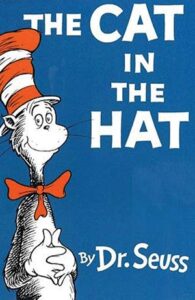 Today we are going to read a book called The Cat in the Hat. The author and illustrator of the book is Dr. Seuss. A hat is something we wear on our head.
Today we are going to read a book called The Cat in the Hat. The author and illustrator of the book is Dr. Seuss. A hat is something we wear on our head.
[Display book cover.]
Let’s look at the title of our book.
[Read title again as you point to each word.]
I am going to say the two parts of one of the words in the title of our book. We can figure out the word by putting the two parts together. Listen carefully as I say the two parts of the word: ca-t. I will say it again: ca-t.
What is the word?
Yes! We have the word “cat” when we put “ca” and “t” together.
[As you read the book, highlight the two parts of the words “cat” and “hat”—ca-t, ha-t—each time they occur. Pause briefly between the first part (body) and the /t/ sound (coda). Example: “We looked! And we saw him! The Ca-t in the Ha-t!” Encourage children to figure out the word by putting the two parts together.]
We heard the words “ca-t” and “ha-t” many times in our book. We said the two parts together to figure out the word!
Now we are going to learn a different letter of the alphabet.
[Display letter W card.]
Does anyone know the name of this letter?
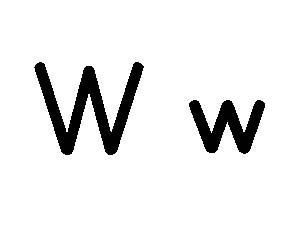 This is the letter W. We can write the letter W in two ways. We can write the letter W like this.
This is the letter W. We can write the letter W in two ways. We can write the letter W like this.
[Demonstrate writing an uppercase W at the top of a chart paper.]
This is an uppercase W.
We can also write the letter W like this.
[Demonstrate writing a lowercase w at the top of a chart paper.]
This is a lowercase w.
We know that the word “weight” means how heavy something is. We can shift our weight from one leg to the other leg.
[Demonstrate shifting your weight from one leg to the other leg.]
The word “weight” begins with the letter w. I will write the word “weight” on our chart. I am going to write “weight” with a lowercase (small letter) w.
[Say each letter as you write the word. Emphasize w.]
Let’s all say the word “weight.”
[Invite a volunteer child to point to the letter w in the word “weight.”]
Let’s look at the very first letter of our name. Pop up if you have the letter W at the beginning of your name. Remember, names begin with an uppercase (big) letter.
[Encourage children to look at their name cards. Say the first names of children who have a W at the beginning of their name. If there are children whose name begins with the letter W who do not stand, point to the letter W on their name card. Compare the letter W in their name as you hold the letter W card next to their name card.
If no one in the group has a first name beginning with the letter W, say “No one popped up because no one has a name that starts with the letter W.” Encourage children to look at the list of children’s first names. Point to some first letters of names. Explain that no one’s name begins with the letter W.
If a child indicates there is a letter W in his/her name, but not at the beginning of the name, fully recognize the name and invite the child to pop up. Day 4 gives attention to the letter w that appears somewhere else in a child’s name.]
Today we read the book The Cat in the Hat. We listened to the two parts of the words ca-t and ha-t. When we put the two parts together, we can figure out the word.
We also learned about the letter W. What word begins with the letter w? (weight)
Extra support
Enrichment
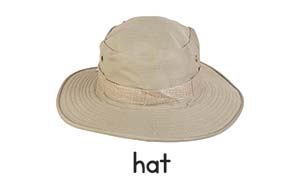
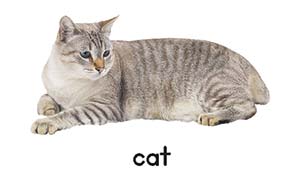 Provide the book used in today’s activity and *picture cards of a cat and hat. Encourage children to say the two parts of the words as they retell the story. Example: “We looked! And we saw him! The Ca-t in the Ha-t!”
Provide the book used in today’s activity and *picture cards of a cat and hat. Encourage children to say the two parts of the words as they retell the story. Example: “We looked! And we saw him! The Ca-t in the Ha-t!”
*Printables provided
Invite school-age children to read to younger children the book used in today’s activity. Encourage all children to say the two parts of the words “ca-t” and “ha-t” as they read or listen to the book.
Measurement knowledge
Children will understand how to measure items with a ruler.


New:
Review:
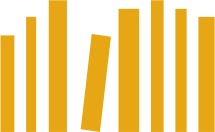
Yesterday we used our hands to measure things in our room. We know that if our hand is a different size than our neighbor’s hand, each of us will have a different number of hands for the size of something.
There is a tool people can use to measure how long or tall something is. The tool is called a ruler.
[Display 3–4 different types of rulers.]
We use a ruler to measure the length and height of things. Remember, length is how long something is and height is how tall something is.
Most rulers are the same size. The rulers we just looked at are made of different things. But they are the same size.
[Display the lengths of the rulers by holding them together at their ends.]
Are our hands the same size?
Rulers are a better way to measure things because most rulers are the same size.
Let’s measure a table with a ruler. We measure with a ruler the same way we measured with our hands. We line up the ruler with the edge of the item we are going to measure. Then we put our finger at the end of the ruler to mark where we will place the ruler again.
I will show you how to measure something with a ruler.
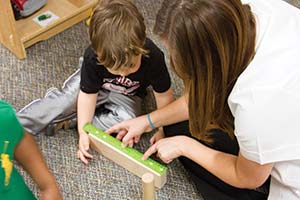 [Demonstrate by laying the ruler on the edge of the table and putting your finger at the end of the ruler to mark where the ruler should be placed again. Move the ruler across the table. Line up the end of the ruler with your finger each time. Count together how many “rulers long” the table is. Invite children to join you in counting each ruler length as you move the ruler across the table.]
[Demonstrate by laying the ruler on the edge of the table and putting your finger at the end of the ruler to mark where the ruler should be placed again. Move the ruler across the table. Line up the end of the ruler with your finger each time. Count together how many “rulers long” the table is. Invite children to join you in counting each ruler length as you move the ruler across the table.]
How many rulers did we count?
The table is ___ rulers long! I put a ruler on the table end to end ___ times. The table is as long as ___ rulers.
Do you think the table will be the same number of rulers long if someone else measures it?
Let’s try it and see!
[Invite a volunteer child to use the ruler to measure the table. Help the child as he/she follows the procedure described above.]
How many rulers did we count when (child’s name) used the ruler to measure the table?
(Child’s name) put a ruler on the table end to end ___ times. The table was still ___ rulers long! Rulers are better than our hands for finding the size of something because most rulers are the same size.
Today we learned that a ruler is a tool we can use to measure how long and how tall something is. We practiced finding how many “rulers long” the table is.
Let’s take a closer look at some rulers.
[Distribute rulers for children to touch and see up close.]
Extra support
Enrichment
Supply several rulers. Encourage children to work in pairs as they manipulate rulers while practicing how to measure large items in the room. Children may wish to take turns placing their finger at the end of the ruler to mark where the ruler should be placed again.
Invite school-age children to use rulers to measure large items outdoors. Encourage younger children to join older children in counting aloud the number of “rulers long” something is.
Executive function
Children will remember actions that correspond to specific sounds.


Review:
Be Prepared: If time permits, offer Music Marks from Week 25, Day 1 as a second game. If the game described below is too challenging for a majority of children, stop at an appropriate place and offer Music Marks from Week 25, Day 1. The game for today may be less challenging when offered again at a later point.
Today we will play a game that we’ve played before. It is a game played with music, and it is called Musical Simon Says. Who remembers what we do during this game?
We will use three musical instruments to play this game. We will use rhythm sticks, cymbals, and a triangle. Let’s listen to the sound of each instrument first.
[Play each instrument, one at a time, and describe its sound. Example: “A triangle makes a ‘ting, ting’ sound.”]
Each time I play one of the instruments, we are going to move our bodies in a certain way. When I stop playing an instrument, we will freeze and stop moving our bodies. Let’s practice with the rhythm sticks first. Remember, when we practice, we do something many times so we can get better at it. Let’s wiggle our knees when we hear the rhythm sticks.
[Play the rhythm sticks for several seconds as children practice wiggling their knees.]
Now let’s clap our hands when we hear the cymbals.
[Play the cymbals for several seconds as children practice clapping their hands.]
Our last instrument is the triangle. Let’s tap our knees when we hear the triangle.
[Play the triangle for several seconds as children practice tapping their knees.]
Great job moving parts of your body in different ways! Now when I play each instrument, we’ll move our bodies the way we practiced.
Let’s try it!
[Play each instrument for several seconds as children move their bodies in the intended ways. As children become more accustomed to the movement associated with the sound of each instrument, play each instrument for a shorter period of time.]
Today we played a game we’ve played before. What did we do when we heard the musical instruments during the Musical Simon Says game?
Extra support
Enrichment
Provide several different musical instruments and encourage children to continue playing Musical Simon Says.
Invite children to tell family members about the Musical Simon Says game at pickup time. Encourage families to try it at home. If you do not have musical instruments, use items from your home. Examples: hitting a plastic bowl with a wooden spoon, tapping two spoons together, banging two small boxes together.
Skills that support creative expression
Children will create dance movements using their legs.


Review:

Be Prepared: Arrange children in their personal spaces so they do not unintentionally hit each other while moving their legs.
Yesterday we were choreographers. Each of us created dance movements with one part of our body. What part of our body did we use for our dance movements? (arms)
Today we will again be choreographers. We will create dance movements using our legs only. Each of us can imagine and try different types of dance movements. Remember, being creative means we use an idea to make or do something new.
Let’s practice some dance movements we can make with our legs.
[Demonstrate and encourage children to try the following movements:]
We can put our different movements together to create a dance with our legs. Remember, today we are creating dance movements with our legs only.
[Describe and demonstrate putting several leg movements together. Example: “We can move a leg forward and then backward and then move our leg to the side of our body.”]
Now I will play some music, and we can create a dance using only our legs. Remember to stay in your personal space. Our dance does not need to look like anyone else’s dance.
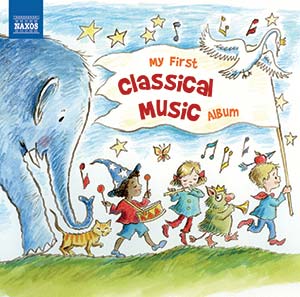 [Play part of Track six on the My First Classical Music Album CD. Demonstrate and encourage children to join in dancing with their legs.]
[Play part of Track six on the My First Classical Music Album CD. Demonstrate and encourage children to join in dancing with their legs.]
Today we created some dance movements using our legs only. What was it like to dance with your legs only?
Extra support
Enrichment
Provide a music player, music, and small bells for children to wear around their ankles, if available. Encourage children to create leg movements that sometimes (but not always) make a bell ring.
If you have access to the Internet, invite children to watch an Irish dance performance. Encourage children to watch and discuss how the dancers move using their legs while holding the rest of their bodies still.